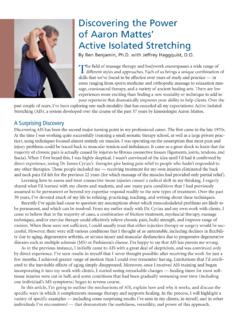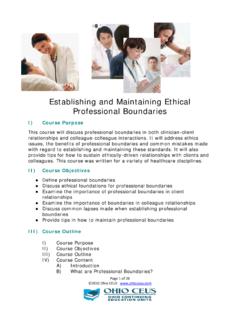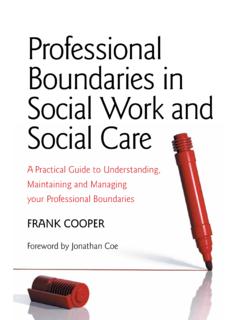Transcription of Spa Legal Liability: How to hire well and protect your ...
1 Spa Legal Liability: How to hire well and protect your business By Ben E. Benjamin, & diane trieste The risk of litigation relating to massage therapists is an issue that no spa can afford to ignore. In recent years, this has become increasingly clear to us. Lately, Ben has been called upon as an expert witness in several cases involving sexual abuse related to massage therapists within a spa environment. During his research for these cases, he noticed a wide variation among spas in the standards for three critical areas surrounding the employment of massage therapists: screening and hiring, orientation and training, and ongoing supervision. He was surprised to learn that even the larger spa organizations had deficiencies in these areas that left their clientele at risk and their organizations vulnerable to major lawsuits. The field of massage therapy and bodywork has grown to include hundreds of schools and several hundred thousand therapists.
2 Massage has become an increasingly important part of the spa industry. On average, massage treatments generate a full 47 percent of a spa's revenue, with an additional 15% of revenue coming from wet treatments. Treatment rooms take up an average of 39% of a spa's indoor space. Whether you are a small spa or a large one, hiring and retaining quality massage therapists is vital to your success and survival. If the spa industry is to maintain or increase its stature as a destination for stress relief and wellness enhancement, it must screen, train, and supervise its massage therapy staff with consistency and care. Why should a spa take on the work of scrutinizing its massage therapists so closely? After all, the vast majority of therapists are decent, ethical, talented, and hard-working professionals, and the efforts involved in screening and supervision may seem unnecessary and excessive. Unfortunately, we live in a litigious society where any business may be one lawsuit away from bankruptcy or a destroyed reputation.
3 On the other hand, an organization that employs highly skilled, responsible therapists in a positive work environment can expect to enjoy solid success for many years to come. A spa that devotes time and energy to hiring and retaining quality massage therapists is making a very worthwhile investment. For all of these reasons, it is critical for the spa industry to identify and adhere to certain minimum standards of practice; only in this way can it weed out the small percentage of practitioners who are emotionally troubled, deviant, or criminal. A spa that hires poorly or does not provide adequate training, development, and supervision becomes a revolving door through which therapists come and go, leaving the business vulnerable and increasing the likelihood of lawsuits for inappropriate behavior. If a claim is filed against a spa for sexual abuse on its premises, the business must expend an enormous amount of energy to defend itself.
4 If the spa is found negligent, it may face not only a damaged reputation and lost revenue, but also increased insurance costs. In this article, we will outline in some detail the processes by which a spa can hire, orient, train, and supervise massage therapists to be ethical and successful representatives of the spa and to ensure a long- lasting and thriving business. These recommendations are based on Dr Benjamin's more than 30 years of experience running a massage therapy school, training and hiring massage therapists, and teaching courses on ethics and professional conduct to students and therapists across the country as well as diane 's 13 years of experience working in spa operations, which includes implementing courses on best practices and interviewing, training, hiring, and managing hundreds of massage therapists. THE HIRING PROCESS. To ensure the hiring of quality therapists, spas must take four major steps: establishing entry criteria, designing an application form, conducting in-person assessments, and checking references.
5 Establishing Entry Criteria A spa's first responsibility in the process of hiring massage therapists is to define its expectations of this subset of employees. Listed below are seven basic areas that should be covered on an application form. Managers at each spa must prioritize these areas to determine which will most readily identify the type of therapist they want to hire and retain. 1. Licensure. Spa managers must familiarize themselves with the laws governing massage therapist licensure in their geographic area. At the present time, 36 states plus the District of Columbia regulate massage therapy at the state level; in the remaining states, individual localities determine their own requirements for licensure. Even in states where massage therapists are state certified, therapists generally must also apply locally for a business license. Applicants for massage therapist positions should submit copies of these documents and should be questioned about whether they have ever been licensed elsewhere.
6 2. National certification. The National Certification Board for Therapeutic Massage and Bodywork (NCBTMB) was established in 1992. Its function is to certify that individual therapists have achieved a minimum standard of massage training and education. To accomplish this goal it administers a national examination, which is revised and updated yearly. Many states require massage therapists to pass this exam in order to obtain a license, but some do not. Whether or not your state has this requirement, you may choose to include NCBTMB certification as part of your spa's screening process. A therapist who takes and passes the NCBTMB exam demonstrates a high level of commitment to obtaining the credentials needed for professional recognition in the field. To maintain national certification status, practitioners must complete NCBTMB continuing education requirements every four years, including six hours of ethics training.
7 Massage therapist applicants who are nationally certified should provide you with a copy of their certificate. 3. Membership in a reputable professional organization. Most massage therapists are members of a national professional organization. The American Massage Therapy Association (AMTA), the Associated Bodywork and Massage Professionals (ABMP), and the American Organization for Bodywork Therapies of Asia (AOBTA) are the largest and best known of these groups. Each group offers various levels of membership, and any therapist applying to be a working professional member must meet certain requirements of training and/or certification. Thus, membership in one of these organizations can corroborate the applicant's qualifications. Such a membership also demonstrates that the therapist has agreed in principle to abide by a specific code of professional ethics. 4. Proof of liability insurance. Working professional members of AMTA or ABMP.
8 Automatically qualify for $2 3 million of professional liability insurance. Therapists also have other options for obtaining professional liability coverage and should provide the spa with a copy of their certificate of coverage. In most cases, therapists can obtain an additional insured endorsement naming the spa from their insurance carrier. 5. School(s) attended. At the time of this writing, approximately 1,500 schools in the United States teach massage and bodywork. Some of these schools are excellent, while others are mediocre or poor. Of course, attendance at an excellent school does not guarantee excellence in the student, and some excellent therapists have attended poor schools. Still, a school's reputation and standards are important to consider. In some cases spa managers may have first-hand knowledge of the quality of an applicant's school, but in many cases, they do not. Two key benchmarks can help to distinguish a good school from a poor one.
9 First, is the school licensed by the state government? Depending on the state, this usually means that the school has filed a lengthy application and has received official approval for its program. Second, is the school accredited? If so, that school has taken a further step toward excellence, as the accreditation process is fairly arduous and intellectually rigorous. An accredited school generally has a higher standard of professionalism. 6. Hours of education and experience. Another important criterion is the number of hours of training a therapist has completed. You may choose to require a copy of the applicant's certificate of graduation, which will state the number of hours included in the training program. The national minimum standard is 500 hours of in-class training. However, developing skill as a therapist requires more hours, which may be obtained through continuing education (see Additional training, below) or through maintaining a private practice for a number of years.
10 A new graduate massage therapist who completed a training program in only a few months is not likely to be highly competent. It takes training over a span of time in order for therapists to gain the experience they need to deal with clients in a skillful and professional manner. When evaluating practical experience, consider not only the length of time the therapist has been practicing, but also the average number of treatments performed per week. For example, a therapist with 5 years of experience who performs only 2 treatments per week may not have developed the same skill as a therapist with 3 years of experience performing 20 treatments per week. 7. Additional training. Serious applicants whose school programs include fewer than 500 hours of training usually seek continuing education to enhance their skills. In addition, ongoing continuing education credits are often required to renew membership in professional and certifying organizations.






